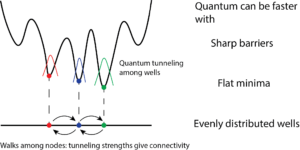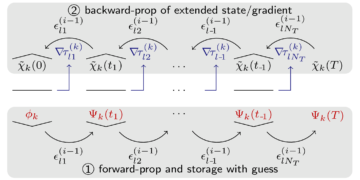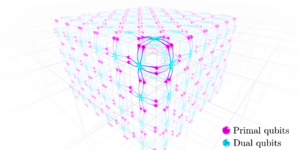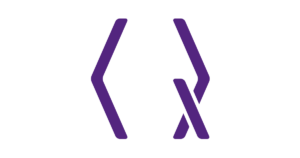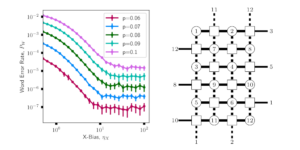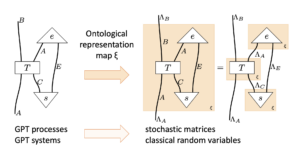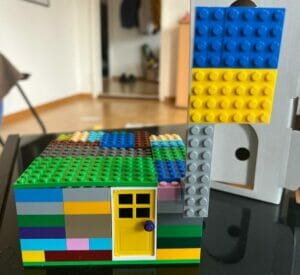1Department of Physics, University of California, Berkeley, CA 94720, USA
2Department of Electrical Engineering and Computer Sciences, University of California, Berkeley, CA 94720, USA
3Challenge Institute for Quantum Computation, University of California, Berkeley, CA 94720, USA
4Sandia National Laboratories, Albuquerque, NM 87123, USA
5Department of Physics and Astronomy, University of New Mexico, Albuquerque, NM 87131, USA
6Center for Quantum Information and Control, University of New Mexico, Albuquerque, NM 87131, USA
Find this paper interesting or want to discuss? Scite or leave a comment on SciRate.
Abstract
Most near-term quantum information processing devices will not be capable of implementing quantum error correction and the associated logical quantum gate set. Instead, quantum circuits will be implemented directly using the physical native gate set of the device. These native gates often have a parameterization (e.g., rotation angles) which provide the ability to perform a continuous range of operations. Verification of the correct operation of these gates across the allowable range of parameters is important for gaining confidence in the reliability of these devices. In this work, we demonstrate a procedure for sample-efficient verification of continuously-parameterized quantum gates for small quantum processors of up to approximately 10 qubits. This procedure involves generating random sequences of randomly-parameterized layers of gates chosen from the native gate set of the device, and then stochastically compiling an approximate inverse to this sequence such that executing the full sequence on the device should leave the system near its initial state. We show that fidelity estimates made via this technique have a lower variance than fidelity estimates made via cross-entropy benchmarking. This provides an experimentally-relevant advantage in sample efficiency when estimating the fidelity loss to some desired precision. We describe the experimental realization of this technique using continuously-parameterized quantum gate sets on a trapped-ion quantum processor from Sandia QSCOUT and a superconducting quantum processor from IBM Q, and we demonstrate the sample efficiency advantage of this technique both numerically and experimentally.
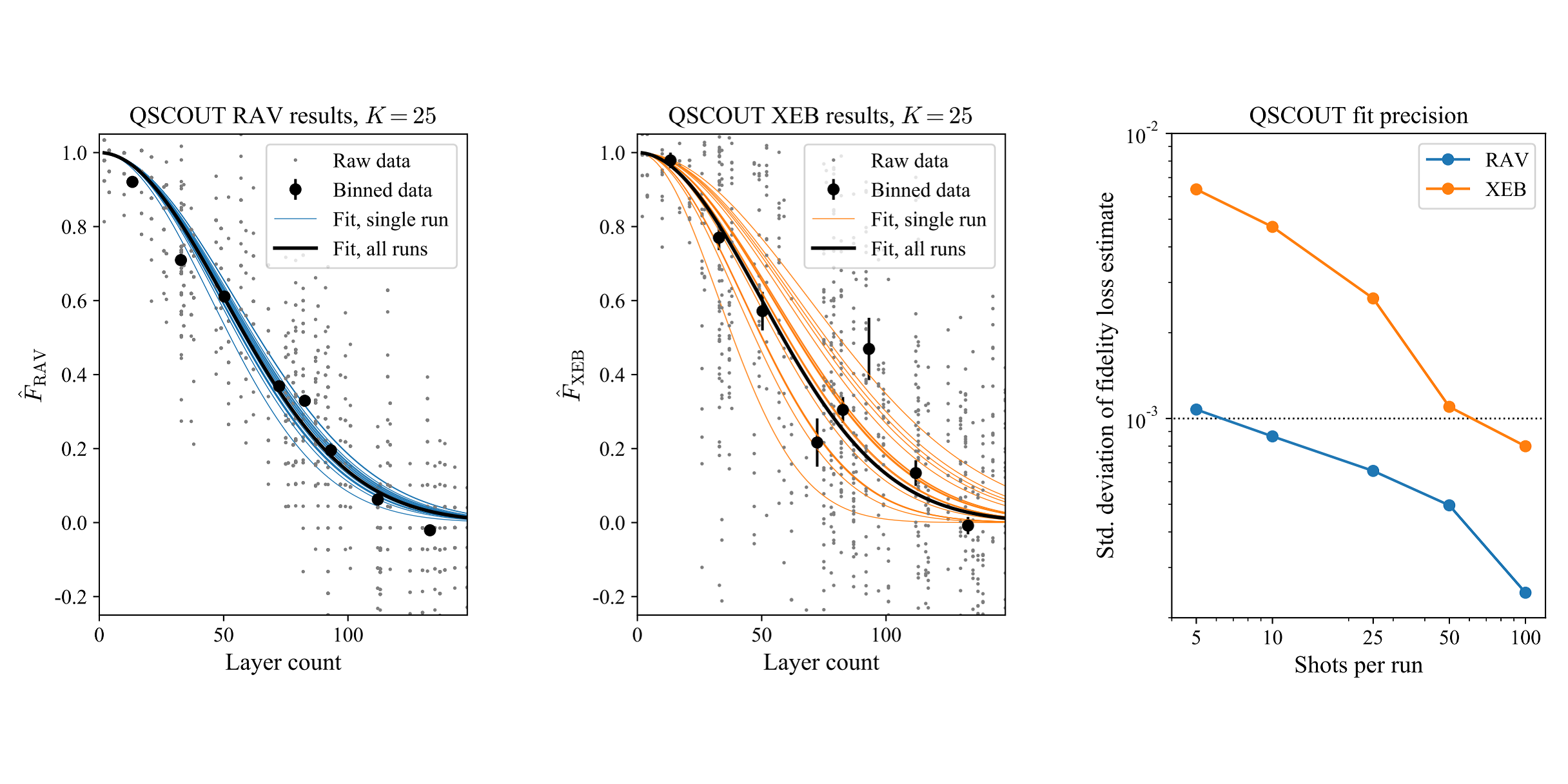
Featured image: Experimental results from Sandia QSCOUT for two-qubit randomized analog verification (RAV) and cross-entropy benchmarking (XEB) runs, demonstrating that fidelity estimates produced by RAV have a lower variance than fidelity estimates produced by XEB. This provides an experimentally-relevant advantage in sample efficiency when estimating the fidelity loss to some desired precision.
Popular summary
A well-known existing technique for this task is cross-entropy benchmarking (XEB), which works by running randomized programs on the quantum computer and comparing the observed output distribution with the ideal output distribution. In contrast, RAV works by designing randomized programs that have an ideal output distribution which is highly concentrated on a single outcome. This means that RAV requires observing only the output probability of this single outcome, rather than the full output distribution. We show that this leads to a significant efficiency advantage over XEB when estimating the imperfection of a device’s operations. We also demonstrate this advantage experimentally on trapped-ion and superconducting quantum processors.
We believe that this efficiency improvement will help to speed up verification of calibration runs for near-term quantum computers, which should improve the availability and stability of these devices.
► BibTeX data
► References
[1] Alexandru Gheorghiu, Theodoros Kapourniotis, and Elham Kashefi. “Verification of Quantum Computation: An Overview of Existing Approaches”. Theory of Computing Systems 63, 715–808 (2019).
https://doi.org/10.1007/s00224-018-9872-3
[2] P. Walther, K. J. Resch, T. Rudolph, E. Schenck, H. Weinfurter, V. Vedral, M. Aspelmeyer, and A. Zeilinger. “Experimental one-way quantum computing”. Nature 434, 169–176 (2005).
https://doi.org/10.1038/nature03347
[3] Marcus Cramer, Martin B. Plenio, Steven T. Flammia, Rolando Somma, David Gross, Stephen D. Bartlett, Olivier Landon-Cardinal, David Poulin, and Yi Kai Liu. “Efficient quantum state tomography”. Nature Communications 1, 149 (2010).
https://doi.org/10.1038/ncomms1147
[4] Seth T. Merkel, Jay M. Gambetta, John A. Smolin, Stefano Poletto, Antonio D. Córcoles, Blake R. Johnson, Colm A. Ryan, and Matthias Steffen. “Self-consistent quantum process tomography”. Physical Review A 87, 062119 (2013).
https://doi.org/10.1103/PhysRevA.87.062119
[5] Robin Blume-Kohout, John King Gamble, Erik Nielsen, Kenneth Rudinger, Jonathan Mizrahi, Kevin Fortier, and Peter Maunz. “Demonstration of qubit operations below a rigorous fault tolerance threshold with gate set tomography”. Nature Communications 8, 14485 (2017).
https://doi.org/10.1038/ncomms14485
[6] Erik Nielsen, John King Gamble, Kenneth Rudinger, Travis Scholten, Kevin Young, and Robin Blume-Kohout. “Gate Set Tomography”. Quantum 5, 557 (2021).
https://doi.org/10.22331/q-2021-10-05-557
[7] A. Shabani, R. L. Kosut, M. Mohseni, H. Rabitz, M. A. Broome, M. P. Almeida, A. Fedrizzi, and A. G. White. “Efficient measurement of quantum dynamics via compressive sensing”. Physical Review Letters 106, 100401 (2011).
https://doi.org/10.1103/PhysRevLett.106.100401
[8] B. P. Lanyon, C. Maier, M. Holzäpfel, T. Baumgratz, C. Hempel, P. Jurcevic, I. Dhand, A. S. Buyskikh, A. J. Daley, M. Cramer, M. B. Plenio, R. Blatt, and C. F. Roos. “Efficient tomography of a quantum many-body system”. Nature Physics 13, 1158–1162 (2017).
https://doi.org/10.1038/nphys4244
[9] Joseph Emerson, Robert Alicki, and Karol Zyczkowski. “Scalable noise estimation with random unitary operators”. Journal of Optics B: Quantum and Semiclassical Optics 7, S347 (2005).
https://doi.org/10.1088/1464-4266/7/10/021
[10] E. Knill, D. Leibfried, R. Reichle, J. Britton, R. B. Blakestad, J. D. Jost, C. Langer, R. Ozeri, S. Seidelin, and D. J. Wineland. “Randomized benchmarking of quantum gates”. Physical Review A 77, 012307 (2008).
https://doi.org/10.1103/PhysRevA.77.012307
[11] Alexander Erhard, Joel J. Wallman, Lukas Postler, Michael Meth, Roman Stricker, Esteban A. Martinez, Philipp Schindler, Thomas Monz, Joseph Emerson, and Rainer Blatt. “Characterizing large-scale quantum computers via cycle benchmarking”. Nature Communications 10, 5347 (2019).
https://doi.org/10.1038/s41467-019-13068-7
[12] Timothy J. Proctor, Arnaud Carignan-Dugas, Kenneth Rudinger, Erik Nielsen, Robin Blume-Kohout, and Kevin Young. “Direct Randomized Benchmarking for Multiqubit Devices”. Physical Review Letters 123, 030503 (2019).
https://doi.org/10.1103/PhysRevLett.123.030503
[13] Timothy Proctor, Stefan Seritan, Kenneth Rudinger, Erik Nielsen, Robin Blume-Kohout, and Kevin Young. “Scalable Randomized Benchmarking of Quantum Computers Using Mirror Circuits”. Physical Review Letters 129, 150502 (2022).
https://doi.org/10.1103/PhysRevLett.129.150502
[14] Sergio Boixo, Sergei V. Isakov, Vadim N. Smelyanskiy, Ryan Babbush, Nan Ding, Zhang Jiang, Michael J. Bremner, John M. Martinis, and Hartmut Neven. “Characterizing quantum supremacy in near-term devices”. Nature Physics 14, 595–600 (2018).
https://doi.org/10.1038/s41567-018-0124-x
[15] Jahan Claes, Eleanor Rieffel, and Zhihui Wang. “Character Randomized Benchmarking for Non-Multiplicity-Free Groups With Applications to Subspace, Leakage, and Matchgate Randomized Benchmarking”. PRX Quantum 2, 010351 (2021).
https://doi.org/10.1103/PRXQuantum.2.010351
[16] Jonas Helsen, Sepehr Nezami, Matthew Reagor, and Michael Walter. “Matchgate benchmarking: Scalable benchmarking of a continuous family of many-qubit gates”. Quantum 6, 657 (2022).
https://doi.org/10.22331/q-2022-02-21-657
[17] John Preskill. “Quantum Computing in the NISQ era and beyond”. Quantum 2, 79 (2018).
https://doi.org/10.22331/q-2018-08-06-79
[18] Anders Sørensen and Klaus Mølmer. “Quantum computation with ions in thermal motion”. Physical Review Letters 82, 1971 (1999).
https://doi.org/10.1103/PhysRevLett.82.1971
[19] Klaus Mølmer and Anders Sørensen. “Multiparticle Entanglement of Hot Trapped Ions”. Physical Review Letters 82, 1835–1838 (1999).
https://doi.org/10.1103/PhysRevLett.82.1835
[20] Esteban A. Martinez, Thomas Monz, Daniel Nigg, Philipp Schindler, and Rainer Blatt. “Compiling quantum algorithms for architectures with multi-qubit gates”. New Journal of Physics 18, 063029 (2016).
https://doi.org/10.1088/1367-2630/18/6/063029
[21] V. Nebendahl, H. Häffner, and C. F. Roos. “Optimal control of entangling operations for trapped-ion quantum computing”. Physical Review A 79, 012312 (2009).
https://doi.org/10.1103/PhysRevA.79.012312
[22] Jordan Hines, Marie Lu, Ravi K. Naik, Akel Hashim, Jean-Loup Ville, Brad Mitchell, John Mark Kriekebaum, David I. Santiago, Stefan Seritan, Erik Nielsen, Robin Blume-Kohout, Kevin Young, Irfan Siddiqi, Birgitta Whaley, and Timothy Proctor. “Demonstrating scalable randomized benchmarking of universal gate sets” (2022). arXiv:2207.07272.
arXiv:2207.07272
[23] T. Chasseur and F. K. Wilhelm. “Complete randomized benchmarking protocol accounting for leakage errors”. Physical Review A 92, 042333 (2015).
https://doi.org/10.1103/PhysRevA.92.042333
[24] Tobias Chasseur, Daniel M. Reich, Christiane P. Koch, and Frank K. Wilhelm. “Hybrid benchmarking of arbitrary quantum gates”. Physical Review A 95, 062335 (2017).
https://doi.org/10.1103/PhysRevA.95.062335
[25] Frank Arute, Kunal Arya, Ryan Babbush, Dave Bacon, Joseph C. Bardin, Rami Barends, Rupak Biswas, Sergio Boixo, Fernando G. S. L. Brandao, David A. Buell, Brian Burkett, Yu Chen, Zijun Chen, Ben Chiaro, Roberto Collins, William Courtney, Andrew Dunsworth, Edward Farhi, Brooks Foxen, Austin Fowler, Craig Gidney, Marissa Giustina, Rob Graff, Keith Guerin, Steve Habegger, Matthew P. Harrigan, Michael J. Hartmann, Alan Ho, Markus Hoffmann, Trent Huang, Travis S. Humble, Sergei V. Isakov, Evan Jeffrey, Zhang Jiang, Dvir Kafri, Kostyantyn Kechedzhi, Julian Kelly, Paul V. Klimov, Sergey Knysh, Alexander Korotkov, Fedor Kostritsa, David Landhuis, Mike Lindmark, Erik Lucero, Dmitry Lyakh, Salvatore Mandrà, Jarrod R. McClean, Matthew McEwen, Anthony Megrant, Xiao Mi, Kristel Michielsen, Masoud Mohseni, Josh Mutus, Ofer Naaman, Matthew Neeley, Charles Neill, Murphy Yuezhen Niu, Eric Ostby, Andre Petukhov, John C. Platt, Chris Quintana, Eleanor G. Rieffel, Pedram Roushan, Nicholas C. Rubin, Daniel Sank, Kevin J. Satzinger, Vadim Smelyanskiy, Kevin J. Sung, Matthew D. Trevithick, Amit Vainsencher, Benjamin Villalonga, Theodore White, Z. Jamie Yao, Ping Yeh, Adam Zalcman, Hartmut Neven, and John M. Martinis. “Quantum supremacy using a programmable superconducting processor”. Nature 574, 505–510 (2019).
https://doi.org/10.1038/s41586-019-1666-5
[26] Ryan Shaffer, Eli Megidish, Joseph Broz, Wei-Ting Chen, and Hartmut Häffner. “Practical verification protocols for analog quantum simulators”. npj Quantum Information 7, 1–12 (2021).
https://doi.org/10.1038/s41534-021-00380-8
[27] Susan M. Clark, Daniel Lobser, Melissa C. Revelle, Christopher G. Yale, David Bossert, Ashlyn D. Burch, Matthew N. Chow, Craig W. Hogle, Megan Ivory, Jessica Pehr, Bradley Salzbrenner, Daniel Stick, William Sweatt, Joshua M. Wilson, Edward Winrow, and Peter Maunz. “Engineering the Quantum Scientific Computing Open User Testbed”. IEEE Transactions on Quantum Engineering 2, 1–32 (2021).
https://doi.org/10.1109/TQE.2021.3096480
[28] IBM. “IBM Quantum”. url: https://quantum-computing.ibm.com/.
https://quantum-computing.ibm.com/
[29] Aram W. Harrow and Richard A. Low. “Random quantum circuits are approximate 2-designs”. Communications in Mathematical Physics 291, 257–302 (2009).
https://doi.org/10.1007/s00220-009-0873-6
[30] Alexander M. Dalzell, Nicholas Hunter-Jones, and Fernando G. S. L. Brandão. “Random quantum circuits transform local noise into global white noise” (2021). arXiv:2111.14907.
arXiv:2111.14907
[31] Kristine Boone, Arnaud Carignan-Dugas, Joel J. Wallman, and Joseph Emerson. “Randomized benchmarking under different gate sets”. Physical Review A 99, 032329 (2019).
https://doi.org/10.1103/PhysRevA.99.032329
[32] Markus Heinrich, Martin Kliesch, and Ingo Roth. “General guarantees for randomized benchmarking with random quantum circuits” (2022). arXiv:2212.06181.
arXiv:2212.06181
[33] Sumeet Khatri, Ryan LaRose, Alexander Poremba, Lukasz Cincio, Andrew T. Sornborger, and Patrick J. Coles. “Quantum-assisted quantum compiling”. Quantum 3, 140 (2019).
https://doi.org/10.22331/q-2019-05-13-140
[34] Kunal Sharma, Sumeet Khatri, M Cerezo, and Patrick J Coles. “Noise resilience of variational quantum compiling”. New Journal of Physics 22, 043006 (2020).
https://doi.org/10.1088/1367-2630/ab784c
[35] W. K. Hastings. “Monte Carlo sampling methods using Markov chains and their applications”. Biometrika 57, 97–109 (1970).
https://doi.org/10.1093/biomet/57.1.97
[36] Michael A Nielsen. “A simple formula for the average gate fidelity of a quantum dynamical operation”. Physics Letters A 303, 249–252 (2002).
https://doi.org/10.1016/S0375-9601(02)01272-0
[37] R. Islam, W. C. Campbell, T. Choi, S. M. Clark, C. W. S. Conover, S. Debnath, E. E. Edwards, B. Fields, D. Hayes, D. Hucul, I. V. Inlek, K. G. Johnson, S. Korenblit, A. Lee, K. W. Lee, T. A. Manning, D. N. Matsukevich, J. Mizrahi, Q. Quraishi, C. Senko, J. Smith, and C. Monroe. “Beat note stabilization of mode-locked lasers for quantum information processing”. Optics Letters 39, 3238 (2014).
https://doi.org/10.1364/OL.39.003238
[38] D. Hayes, D. N. Matsukevich, P. Maunz, D. Hucul, Q. Quraishi, S. Olmschenk, W. Campbell, J. Mizrahi, C. Senko, and C. Monroe. “Entanglement of Atomic Qubits Using an Optical Frequency Comb”. Physical Review Letters 104, 140501 (2010).
https://doi.org/10.1103/PhysRevLett.104.140501
[39] S. Debnath, N. M. Linke, C. Figgatt, K. A. Landsman, K. Wright, and C. Monroe. “Demonstration of a small programmable quantum computer with atomic qubits”. Nature 536, 63–66 (2016).
https://doi.org/10.1038/nature18648
[40] Kenneth R. Brown, Aram W. Harrow, and Isaac L. Chuang. “Arbitrarily accurate composite pulse sequences”. Physical Review A 70, 052318 (2004).
https://doi.org/10.1103/PhysRevA.70.052318
[41] P. J. Lee, K. A. Brickman, L. Deslauriers, P. C. Haljan, L. M. Duan, and C. Monroe. “Phase control of trapped ion quantum gates”. Journal of Optics B: Quantum and Semiclassical Optics 7, S371 (2005).
https://doi.org/10.1088/1464-4266/7/10/025
[42] Ryan Shaffer (2022). code: rmshaffer/stoq-compiler v0.2.0.
https://github.com/rmshaffer/stoq-compiler
[43] Adriano Barenco, Charles H. Bennett, Richard Cleve, David P. Divincenzo, Norman Margolus, Peter Shor, Tycho Sleator, John A. Smolin, and Harald Weinfurter. “Elementary gates for quantum computation”. Physical Review A 52, 3457 (1995).
https://doi.org/10.1103/PhysRevA.52.3457
[44] George Cybenko. “Reducing quantum computations to elementary unitary operations”. Computing in Science and Engineering 3, 27–32 (2001).
https://doi.org/10.1109/5992.908999
[45] Aram W. Harrow, Benjamin Recht, and Isaac L. Chuang. “Efficient discrete approximations of quantum gates”. Journal of Mathematical Physics 43, 4445–4451 (2002).
https://doi.org/10.1063/1.1495899
[46] Ali Javadiabhari, Shruti Patil, Daniel Kudrow, Jeff Heckey, Alexey Lvov, Frederic T. Chong, and Margaret Martonosi. “ScaffCC: Scalable compilation and analysis of quantum programs”. Parallel Computing 45, 2–17 (2015).
https://doi.org/10.1016/j.parco.2014.12.001
[47] A. Kitaev. “Quantum computations: algorithms and error correction”. Russian Mathematical Surveys 52, 1191–1249 (1997).
https://doi.org/10.1070/RM1997v052n06ABEH002155
[48] Eric Schkufza, Rahul Sharma, and Alex Aiken. “Stochastic superoptimization”. In Proceedings of the 18th International Conference on Architectural Support for Programming Languages and Operating Systems. Pages 305–316. New York (2013). ACM Press.
https://doi.org/10.1145/2451116.2451150
[49] Joel J. Wallman and Joseph Emerson. “Noise tailoring for scalable quantum computation via randomized compiling”. Physical Review A 94, 52325 (2016).
https://doi.org/10.1103/PhysRevA.94.052325
[50] Naomichi Hatano and Masuo Suzuki. “Finding Exponential Product Formulas of Higher Orders”. In Arnab Das and Bikas Chakrabarti, editors, Quantum Annealing and Other Optimization Methods. Chapter 2, pages 37–68. Springer, Berlin (2005).
https://doi.org/10.1007/11526216
[51] Guang Hao Low and Isaac L. Chuang. “Hamiltonian Simulation by Qubitization”. Quantum 3, 163 (2019).
https://doi.org/10.22331/q-2019-07-12-163
[52] Andrew M. Childs, Aaron Ostrander, and Yuan Su. “Faster quantum simulation by randomization”. Quantum 3, 182 (2019).
https://doi.org/10.22331/q-2019-09-02-182
[53] Earl Campbell. “Random Compiler for Fast Hamiltonian Simulation”. Physical Review Letters 123, 070503 (2019).
https://doi.org/10.1103/physrevlett.123.070503
[54] Yingkai Ouyang, David R. White, and Earl T. Campbell. “Compilation by stochastic Hamiltonian sparsification”. Quantum 4, 235 (2020).
https://doi.org/10.22331/q-2020-02-27-235
[55] Francesco Mezzadri. “How to generate random matrices from the classical compact groups” (2006). arXiv:math-ph/0609050.
arXiv:math-ph/0609050
[56] E. Knill. “Approximation by Quantum Circuits” (1995). arXiv:quant-ph/9508006.
arXiv:quant-ph/9508006
[57] David Poulin, Angie Qarry, Rolando Somma, and Frank Verstraete. “Quantum simulation of time-dependent Hamiltonians and the convenient illusion of Hilbert space”. Physical Review Letters 106, 170501 (2011).
https://doi.org/10.1103/PhysRevLett.106.170501
Cited by
[1] Jordan Hines, Marie Lu, Ravi K. Naik, Akel Hashim, Jean-Loup Ville, Brad Mitchell, John Mark Kriekebaum, David I. Santiago, Stefan Seritan, Erik Nielsen, Robin Blume-Kohout, Kevin Young, Irfan Siddiqi, Birgitta Whaley, and Timothy Proctor, “Demonstrating scalable randomized benchmarking of universal gate sets”, arXiv:2207.07272, (2022).
The above citations are from SAO/NASA ADS (last updated successfully 2023-05-05 01:08:43). The list may be incomplete as not all publishers provide suitable and complete citation data.
On Crossref’s cited-by service no data on citing works was found (last attempt 2023-05-05 01:08:41).
This Paper is published in Quantum under the Creative Commons Attribution 4.0 International (CC BY 4.0) license. Copyright remains with the original copyright holders such as the authors or their institutions.
- SEO Powered Content & PR Distribution. Get Amplified Today.
- PlatoAiStream. Web3 Data Intelligence. Knowledge Amplified. Access Here.
- Minting the Future w Adryenn Ashley. Access Here.
- Buy and Sell Shares in PRE-IPO Companies with PREIPO®. Access Here.
- Source: https://quantum-journal.org/papers/q-2023-05-04-997/
- :has
- :is
- :not
- ][p
- $UP
- 1
- 10
- 11
- 12
- 13
- 14
- 15%
- 1999
- 20
- 2001
- 2011
- 2014
- 2015
- 2016
- 2017
- 2018
- 2019
- 2020
- 2021
- 2022
- 22
- 23
- 24
- 26%
- 27
- 28
- 30
- 39
- 40
- 49
- 50
- 7
- 70
- 77
- 8
- 9
- a
- Aaron
- ability
- above
- ABSTRACT
- access
- Accounting
- accurate
- Achieve
- ACM
- across
- Adam
- ADvantage
- affiliations
- Alan
- alex
- Alexander
- algorithms
- All
- also
- an
- analysis
- and
- Andrew
- Anthony
- applications
- approaches
- approximate
- approximately
- architectural
- ARE
- AS
- associated
- astronomy
- austin
- author
- authors
- availability
- average
- BE
- believe
- below
- ben
- benchmarking
- Benjamin
- Berkeley
- Beyond
- both
- Break
- Brian
- but
- by
- CA
- california
- called
- capable
- chains
- Chapter
- Charles
- chen
- chosen
- Chris
- Christopher
- code
- comment
- Common
- Commons
- Communications
- comparing
- complete
- computation
- computations
- computer
- computers
- computing
- Concentrated
- Conference
- confidence
- continuous
- contrast
- control
- Convenient
- copyright
- correct
- Craig
- cycle
- Daniel
- data
- Dave
- David
- demonstrate
- demonstrating
- describe
- designing
- desired
- device
- Devices
- different
- directly
- discuss
- distribution
- dynamics
- e
- each
- Edward
- efficiency
- efficient
- Engineering
- Era
- error
- Errors
- estimates
- executing
- existing
- exponential
- family
- far
- FAST
- fidelity
- Fields
- For
- formula
- found
- Frequency
- frequent
- from
- full
- future
- Gain
- gaining
- Gamble
- Gates
- generate
- generating
- George
- Global
- goal
- gross
- Group’s
- guarantees
- Hang
- harvard
- Have
- help
- High
- higher
- highly
- holders
- HOT
- HTTPS
- i
- IBM
- ideal
- IEEE
- Illusion
- image
- implement
- implemented
- implementing
- implements
- important
- improve
- improvement
- in
- information
- initial
- instead
- Institute
- institutions
- interesting
- International
- into
- introduce
- IT
- ITS
- Jamie
- JavaScript
- John
- Johnson
- Jordan
- journal
- just
- King
- Koch
- Languages
- large-scale
- lasers
- Last
- layers
- Leads
- Leave
- Lee
- License
- like
- likely
- List
- local
- logical
- Long
- loss
- Low
- lower
- made
- Maier
- Marcus
- mark
- Martin
- mathematical
- matthew
- max-width
- May..
- mcclean
- means
- measurement
- methods
- Mexico
- Michael
- mirror
- Month
- more
- most
- motion
- National
- native
- Nature
- Near
- needed
- New
- New York
- no
- Noise
- of
- often
- Olivier
- on
- only
- open
- operate
- operating
- operating systems
- operation
- Operations
- operators
- optics
- optimization
- or
- orders
- original
- Other
- Outcome
- output
- over
- overview
- Paper
- Parallel
- parameters
- particular
- Paul
- Perform
- Peter
- peter shor
- physical
- Physics
- ping
- plato
- Plato Data Intelligence
- PlatoData
- Precision
- press
- Proceedings
- process
- processing
- Processor
- processors
- Produced
- Product
- Programming
- programming languages
- Programs
- protocol
- protocols
- provide
- provides
- published
- publisher
- publishers
- pulse
- Quantum
- quantum algorithms
- Quantum Annealing
- Quantum Computer
- quantum computers
- quantum computing
- quantum error correction
- quantum gate
- quantum information
- Quantum Supremacy
- Qubit
- qubits
- RAMI
- random
- Randomized
- range
- rather
- realization
- references
- reliability
- remains
- ren
- requires
- resilience
- Results
- review
- Richard
- rigorous
- rob
- ROBERT
- Robin
- Run
- running
- russian
- Ryan
- s
- scalable
- Science
- SCIENCES
- scientific
- Sequence
- set
- Sets
- Sharma
- Shor
- should
- show
- significant
- Simple
- simulation
- single
- small
- some
- Space
- speed
- Stability
- State
- Stephen
- Steve
- success
- Successfully
- such
- suitable
- superconducting
- support
- Susan
- system
- Systems
- Task
- techniques
- tests
- than
- that
- The
- The Future
- their
- then
- thermal
- These
- they
- this
- threshold
- Title
- to
- today
- tolerance
- too
- Transactions
- Transform
- under
- Universal
- university
- University of California
- updated
- URL
- use
- User
- using
- Verification
- very
- via
- volume
- W
- want
- was
- we
- well-known
- when
- which
- white
- will
- Wilson
- with
- Work
- works
- Wright
- year
- york
- young
- Yuan
- zephyrnet


